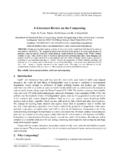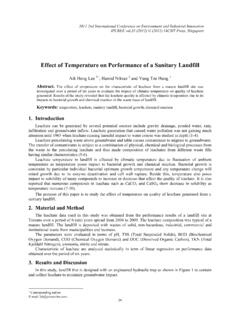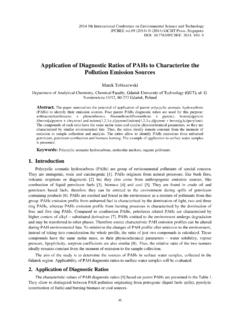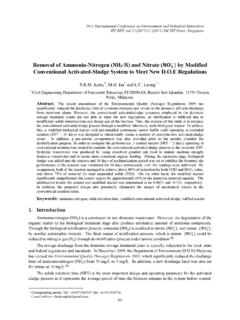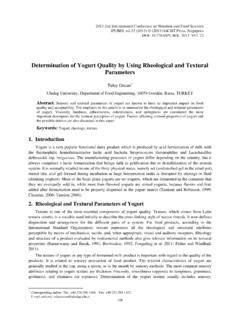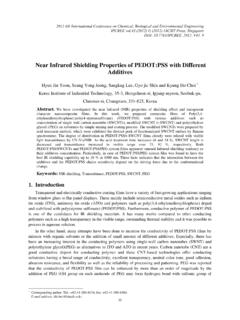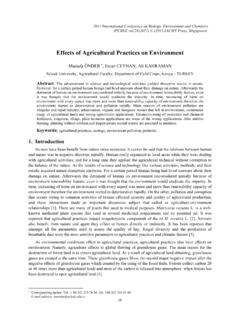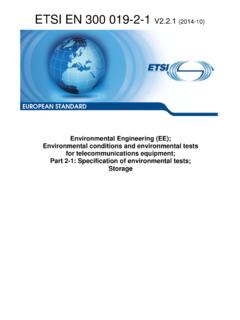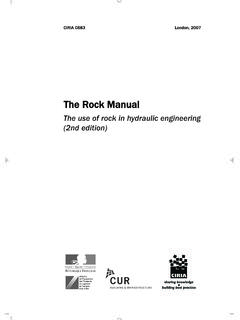Transcription of Wastewater Effluent Discharge: Effects and …
1 Wastewater Effluent discharge : Effects and Treatment Processes Akpor O. B.+ Institute for Economic Research on Innovation, Tshwane University of Technology, 159 Skinner Street, Pretoria, South Africa, Abstract. Wastewater treatment is a vital component in any community without which water-borne pathogens can spread resulting in diseases and degradation of receiving water bodies. This paper was aimed at reviewing the ecological and health impacts of untreated Wastewater effluents and current advances in Wastewater treatment. The pollutants in Wastewater can be divided into two broad categories: biological and chemical, with the major chemical pollutants being nitrogen, phosphorus, heavy metals, detergents, pesticides and hydrocarbons.
2 The majority of waterborne microorganisms that cause human disease come from animal and human fecal wastes. These contain a wide variety of viruses, bacteria, and protozoa that may get washed into drinking water supplies or receiving water bodies. Also, the processes for the removal of impurities in Wastewater can be divided into two: chemical and biological. All biological-treatment processes take advantage of the ability of microorganisms to use diverse Wastewater constituents to provide the energy for microbial metabolism and the building blocks for cell synthesis. Although biological processes have been extensively investigated in Wastewater treatment over the past decades, most investigations have been concentrated on bacteria.
3 More recently, it is now known that a significant fraction of nutrient mineralization taking place in nutrient removal systems may be a result of protozoan activity. Since the performance and evaluation of a country s Wastewater management system cannot be simply attributed to the presence of Acts, policies and guidelines, there is the need for appropriate implementation strategies. This can be enhanced through the utilization of technologies that are most economically useful efficient. Keywords: Wastewater treatment, chemical, biological 1. Introduction Globally, the effluents that are discharged from Wastewater treatment systems represent one of the largest sources of pollution. The negative impacts of these effluents to aquatic ecosystems and to humans, from harmful substances found in them have been documented both at national and international levels Some of these impacts can include death of aquatic life, algal blooms, habitat destruction from sedimentation, debris, and increased water flow and other short and long term toxicity from chemical contaminants; in combination with chemical accumulation and magnification at higher levels of the food chain (Canada Gazzette, 2010).
4 The United Nations General Assembly in the year 2000 adopted the millennium Development Goals (MDGs). The MDG that is most directly related to the safe use and discharge of Wastewater is Goals 8- ensure environmental sustainability. In order to maximize the health and environmental benefits associated with the use and discharge of Wastewater , several legislations and guidelines have been developed, both at international and national levels. The World Health Organisation (WHO) Guidelines for the reuse of effluents were developed in 1973, with revised editions in 1989 and 2006 (WHO, 2006). Previously, many treatment plants were designed to remove nutrients by the addition of chemicals.
5 Since chemical treatment is known to increase sludge volume and often results in sludge with poor settling and dewatering characteristics and the depression of the pH, biological treatment is advocated in recent years. Since large amounts of waste products are passed through sewage treatment systems on a daily basis, appropriate nutrient removal strategy is critical for the preservation of our lakes, streams, rivers and other receiving water bodies (vander Post & Schutte, 2003). This paper was therefore aimed at reviewing the + Phone: +27-12-382-3073, Fax +27-12-382-3071 Email: 2011 3rd International Conference on Chemical, Biological and Environmental Engineering IPCBEE (2011) (2011) IACSIT Press, Singapore 85ecological and health impacts of untreated Wastewater effluents and current advances in nutrient removal from Wastewater .
6 2. Ecological and Health Impacts of Pollutants in Wastewater Wastewater pollution has always been a major problem throughout the world. These pollutants can be divided into two broad categories: biological and chemical (Kris, 2007). Ecological impacts The major chemical pollutants in Wastewater are nitrogen, phosphorus, heavy metals, detergents, pesticides and hydrocarbons. Of these chemicals, the two commonest nutrient limiting ones are nitrogen and phosphorus (Larsdotter, 2006). The presence of nitrogen in Wastewater discharge can be undesirable because it has ecological impacts and also affect public health. The principal forms of nitrogen are organic nitrogen, ammonium (NH4+ or NH3), nitrite (NO2-) and nitrate (NO3-) (Hurse & Connor, 1999).
7 These occurrences are generally associated with disposal of municipal sewage and fertilizer application to agricultural crops. The dangers that all these incidents have posed are a clear indication that nitrogen must be removed from Wastewater before discharge (Kurosu, 2001). Nitrogen in untreated wastewaters is primarily in the form of ammonia and organic nitrogen, both soluble and particulate (Sabalowsky, 1999). A large problem in some plants is a low pH (to as low pH = 6) caused by extensive nitrification and low Wastewater alkalinity. This often causes pin floc and high Effluent turbidity. Some plants reduce aeration to reduce nitrification or add soda ash, lime or magnesium hydroxide as a source of alkalinity if this becomes a problem.
8 The use of lower dissolved oxygen concentration ( mg/l or less) to control nitrification is not without the risk of inducing filamentous bulking by low dissolved oxygen filaments (Jenkins, et al., 2003). During nitrification process, there is always a consumption of alkalinity and a production of alkalinity during denitrification process. In practice, kg of alkalinity of CaCO3 are consumed for every gram of NH3 N oxidized. The hydroxide ions produced during denitrification process result in the replacement of 5 0 % of the alkalinity consumed during nitrification Methemoglobinemia is the most significant health problem associated with nitrate in water. Usually, blood contains an iron-based compound (hemoglobin) that carries oxygen, but when nitrite is present, hemoglobin can be converted to methemoglobin, which cannot carry oxygen.
9 Similarly, nitrogen in the form of ammonia is toxic to fish and exerts an oxygen demand on receiving water by nitrifiers (Jenkins, et al., 2003).. Surface waters can also contain levels of phosphorus in various compounds, which is an essential constituent of living organisms. In natural conditions, phosphorus concentration in waters is balanced; however when phosphorus input to waters is higher than it can be assimilated by a population of living organisms, the problem of excess phosphorus content occurs (Rybicki, 1997). Since phosphate is the limiting component for growth in most ecosystems and emission of phosphate in surface waters leads to eutrophication and algae bloom, thus having negative impacts on nature conservation, recreation and drinking water production, it is necessary to control the emission of phosphates from discharges of Wastewater (van Larsdrecht, 2005).
10 The excess content of phosphorus in receiving waters usually leads to extensive algal growth (eutrophication). Controlling phosphorus discharge from municipal and industrial Wastewater treatment plants is a key factor in preventing eutrophication of surface waters (Department of Natural Science, 2006). The general purpose of phosphorus removal from Wastewater is to eliminate excess phosphorus content discharge to receiving waters and then utilize this excluded phosphorus load in the way which is the most proper for the natural phosphorus cycle in nature. Usually, phosphorus is present in Wastewater in soluble form. Only about 15 % of total phosphorus contained in settleable particles may be removed by primary sedimentation with no metal salt addition.
